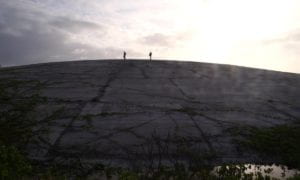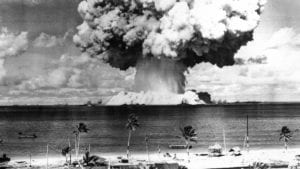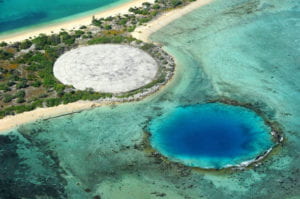by Nicole Ramirez
In the United States, conversations about ocean pollution often revolve around single-use plastics and oil spills. However, nuclear materials produced by the U.S. have also been contributing to ocean pollution, declining ecological welfare, and public health crises since the nation’s involvement in nuclear development at the onset of the Cold War. The U.S. conducted nuclear testing and dumped nuclear waste in the Pacific Ocean during the Cold War, within close proximity to Pacific island nations, and the effects of this nuclear activity have continued to impact the Pacific Islands beyond the period of the Cold War and into the present. The Pacific Islands affected by U.S. nuclear development include communities and nations in Oceania (Melanesia, Micronesia, Polynesia, and Australasia).[1] Although Pacific Islander communities are diverse and cannot be generalized, these communities have had similar experiences with nuclearism, waste, and toxic colonialism, and contamination from nuclear materials has been widespread across the region. Pacific Islander communities have also created multiple pan-Pacific citizen groups and intergovernmental organizations that unite communities against nuclear waste disposal, including the Asian Pacific Parliamentarians’ Union, the South Pacific Forum, and the South Pacific Conference.[2] Thus, this paper will not focus on one nation or community, but on the Pacific Islands as a region. Although the effects of nuclear waste are not immediately visible, the long term effects of public health and environmental crises in the Pacific Islands show the lethal effects of the U.S. dumping nuclear waste.

Toxic colonialism has impacted the Pacific Islands for decades, and the dire effects of nuclear materials in Oceania have continued to impact Pacific Islander communities today. Development scholar R.R. Thaman writes that “the Pacific Islands have one of the most continuous histories of nuclear pollution and are, collectively, one of the most highly militarized regions on earth”[6]. The Pacific Islands’ experience with nuclear testing and nuclear waste began in 1945 when the B-29 Enola Gay, a U.S. plane model, took off from the Northern Mariana Islands and dropped an atomic bomb on Hiroshima.[7] Since, the U.S. has dumped over 100,000 curies, or 100,000 units of radioactive material,[8] of low-level nuclear waste in the Pacific region, and the U.S. has drafted and redrafted plans to sink multiple nuclear submarines, or incinerate nuclear waste in close proximity to the Pacific Islands.[9] According to a 1980 United Nations report over 200 of the 1233 nuclear tests worldwide have taken place in the Pacific Islands.[10]

These colonial ideas about land have caused the U.S. government to render Pacific Islander communities humans-as-waste, meaning that human presence in the Pacific Islands has historically been ignored, exploited, and viewed as secondary to the U.S. government’s goal of staying competitive in Cold War nuclear development. Geographer R. Gerard Ward summarizes how the U.S. colonial gaze has conceptualized the Pacific Islands: “empty, but not useless for outsiders”.[14] This notion of emptiness manifested in treaties that gave the U.S. access to Oceania as a dumping ground. The 1951 Australia, New Zealand, United States Security Treaty (A.N.Z.U.S.) and the 1954 Southeast Asia Treaty Organization (S.E.A.T.O.) established alliances between Australia and the U.S. and New Zealand and the U.S., respectively, with the goal of cooperation on military matters in the Pacific Islands region. U.S. involvement with these Anglo-fied Pacific Islands allowed for U.S. warships to enter the region without declaring the nature of the weapons and nuclear materials they were carrying, making nuclear waste disposal in Oceania more permissible and unregulated.[15] Thus, the U.S. exploited the idea that the Pacific Islands are an empty region, but are useful for nuclear development motives. The lack of regulation that these agreements yielded further rendered Pacific Islander communities humans-as-waste, as they preyed upon the social, racial, and economic inequalities between the global North (the U.S.) and the global South (many Pacific island nations) and exacerbated these power dynamics for the benefit of the global North.

Toxic colonialism manifests in both environmental and public health crises in the Pacific Islands. Scientists and public health experts have identified a correlation between nuclear materials, ecological decline, and high rates of disease in the Pacific Islands, but the U.S. government has consistently failed to accept full responsibility for the role they have played in health crises in the Pacific Islands. In terms of environmental impacts, high islands, like the Federated States of Micronesia, are characterized by steep terrains and rainforests, and are thus susceptible to erosion and stream sedimentation.[18] Atoll islands, like the Marshall Islands, have low biological diversity and a “critical unconfined groundwater system,” making their limited land areas difficult to engage with regeneration.[19] The topographical features of many islands in Oceania make them ecologically fragile, and thus there is no Plan B if ecosystems are irreparably damaged as a result of nuclear pollution and contamination. Native plants that are central to many Pacific Island cultures and are important for maintaining nutrition in the Marshall Islands, Johnston Island, and the Federated States of Micronesia have shown high-radiation levels since studies were conducted in the mid-1970s.[20]
Furthermore, nuclear testing and the dumping of nuclear waste in the Pacific Islands have resulted in high rates of cancer and disease in Pacific Islander communities. Scientists and public health experts have identified a correlation between the 1954 Bravo atmospheric test in the Marshall Islands and high rates of thyroid cancer in Marshallese people.[21] Over 90% of Marshallese children from Rongelap Atoll who were under 12 years old when the Bravo test was conducted have developed thyroid tumors, and 40% of all Marshallese people have developed thyroid problems since 1954.[22] These experts have stated that Bikini Island, in the Marshall Islands, could not have been safely resettled for 20-90 years, and “the U.S. Defense Nuclear Agency, which is responsible for the cleanup, has stated ‘that it is impossible to reduce contamination to pre-test levels”[23].
These health hazards that have impacted both Pacific Islander communities and the environment are possibly the most serious long-term health hazard that the region has ever faced.[24] Yet these statistics and impacts are further complicated by the fact that U.S. military and government representatives did not acknowledge the potentially hazardous impact of their nuclear involvement in the Pacific Islands prior to the development of the statistics above.[25] Prior to the second of two evacuations of Bikini Island, after high radionuclide counts were confirmed in toxicity accounts of Marshallese people, the U.S. Navy published an environmental impact statement claiming that “no measurable amount of radioactivity” would be released into the Pacific Ocean.[26]

This paper only scratches the surface of the various implications of nuclear waste in the Pacific Islands, as there are further issues with regards to the role of indigenous resistance to toxic colonialism and the creation of larger Asia-Pacific community forums, contemporary health and environmental concerns in the region, and what the perpetuation of Pacific region stereotypes looks like today. Nuclear materials in the Pacific Ocean have irreparably impacted ecological welfare and public health in the Pacific Islands, and these issues are deeply embedded within a politicized relationship between the U.S. and the Pacific Islands. The U.S. engaged in toxic colonialism to give themselves an advantage in nuclear development during the Cold War, at the expense of communities and environments in the Pacific Islands.
***
[i] from John Wargo. Green Intelligence: Creating Environments That Protect Human Health. (New Haven: Yale University Press, 2009), 15.
Robert B. Spies, Kenneth V. Marsh and James R. Kercher. Dynamics of Radionuclide Exchange in the Calcareous Algae Halimeda at Enewetak Atoll. Limnology and Oceanography 26, no. 1, (1981): 75, http://www.jstor.org/stable/2835808.
[ii] https://www.northcountrypublicradio.org/news/npr/306540808/pacific-island-nation-sues-u-s-others-for-violating-nuclear-treaty
[iii] http://www.abc.net.au/radionational/programs/saturdayextra/the-inescapable-military-legacy-of-a-pacific-island-paradise/6932650
[iv] https://theconversation.com/bikini-islanders-still-deal-with-fallout-of-us-nuclear-tests-70-years-later-58567
[1] “Methodology: Geographic Regions.” United Nations Statistics Division. Retrieved from https://unstats.un.org/unsd/methodology/m49/
[2] James B. Branch. “The Waste Bin: Nuclear Waste Dumping and Storage in the Pacific.” Ambio 14 no. ⅚, (1984): 330. http://www.jstor.org/stable/4313067.
[3] Joseph Masco. The nuclear borderlands: the Manhattan Project in post-Cold War New Mexico. (Princeton: Princeton University Press, 2006), 145.
[4] R. R. Thaman. “Health and Nutrition in the Pacific Islands: Development or Underdevelopment? GeoJournal 16, no. 2 (1988): 223, http://www.jstor.org/stable/41144198.
[5] “Bioaccumulation,” Dictionary.com, http://www.dictionary.com/browse/bioaccumulation.
[6] Thaman, “Health and Nutrition,” 222.
[7] Branch, “The Waste Bin,” 327.
[8] “Curie,” Encyclopedia Britannica, https://www.britannica.com/science/curie.
[9] Branch, “The Waste Bin,” 328.
[10] Thaman, “Health and Nutrition,” 222-223.
[11] Thaman, “Health and Nutrition,” 222.
[12] Traci Brynne Voyles. Wastelanding: Legacies of Uranium Mining on Navajo Country. (Minneapolis: University of Minnesota Press, 2015), 1-3.
[13] Voyles, Wastelanding, 139.
[14] Gerard R. Ward. “Earth’s Empty Quarter? The Pacific Islands in a Pacific Century.” The Geographical Journal 155, no. 2 (1989): 237, http://www.jstor.org/stable/635065.
[15] Jean-March Renault. “The Nuclear Issue in the South Pacific: Labor Parties, Trade Union Movements, and Island Churches in International Relations.” The Contemporary Pacific 17, no. 2 (2005): 339-340, http://www.jstor.org/stable/23722061.
[16] Voyles, Wastelanding, 25.
[17] Voyles, Wastelanding, 25.
[18] Jon Brodie and John Morrison. “The Management and Disposal of Hazardous Wastes in the Pacific Islands.” Ambio 13, no. ⅚ (1984); 331, http://www.jstor.org/stable/4313068.
[19] Brodie and Morrison, “The Management and Disposal of Hazardous Wastes,” 331.
[20] Thaman, “Health and Nutrition,” 223.
[21] Thaman, “Health and Nutrition,” 223.
[22] Thaman, “Health and Nutrition,” 223.
[23] Thaman, “Health and Nutrition,” 223.
[24] Thaman, “Health and Nutrition,” 223.
[25] Branch, “The Waste Bin,” 327.
[26] Branch, “The Waste Bin,” 327.
[27] Masco, The nuclear borderlands, 161.
